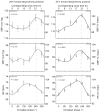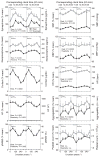The impact of the circadian timing system on cardiovascular and metabolic function
- PMID: 22877674
- PMCID: PMC3704149
- DOI: 10.1016/B978-0-444-59427-3.00019-8
The impact of the circadian timing system on cardiovascular and metabolic function
Abstract
Epidemiological studies show that adverse cardiovascular events peak in the morning (i.e., between 6 AM and noon) and that shift work is associated with cardiovascular disease, obesity, and diabetes. The endogenous circadian timing system modulates certain cardiovascular risk markers to be highest (e.g., cortisol, nonlinear dynamic heart rate control, and platelet activation) or to respond most unfavorably to stressors such as exercise (e.g., epinephrine, norepinephrine, and vagal cardiac modulation) at an internal body time corresponding to the time of day when adverse cardiovascular events most likely occur. This indicates that the circadian timing system and its interaction with external cardiovascular stressors (e.g., physical activity) could contribute to the morning peak in adverse cardiovascular events. Moreover, circadian misalignment and simulated night work have adverse effects on cardiovascular and metabolic function. This suggests that misalignment between the behavioral cycle and the circadian timing system in shift workers contributes to that population's increased risk for cardiometabolic disease.
Copyright © 2012 Elsevier B.V. All rights reserved.
Figures




References
-
- Åkerstedt T. Shift work and disturbed sleep/wakefulness. Sleep Medicine Reviews. 1998;2:117–128. - PubMed
-
- Al-Naimi S, Hampton SM, Richard P, Tzung C, Morgan LM. Postprandial metabolic profiles following meals and snacks eaten during simulated night and day shift work. Chronobiology International. 2004;21:937–947. - PubMed
-
- Balsalobre A, Damiola F, Schibler U. A serum shock induces circadian gene expression in mammalian tissue culture cells. Cell. 1998;93:929–937. - PubMed
-
- Boivin DB, James FO. Circadian adaptation to night-shift work by judicious light and darkness exposure. Journal of Biological Rhythms. 2002;17:556–567. - PubMed
Publication types
MeSH terms
Grants and funding
LinkOut - more resources
Full Text Sources
Medical

